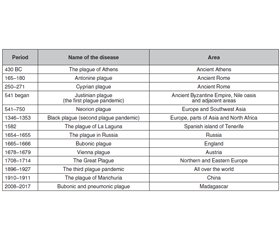Журнал «Медицина неотложных состояний» Том 19, №6, 2023
Вернуться к номеру
Пандемії та їх географічне поширення
Авторы: N. Komilova (1), N. Mukhammedova (2), N. Ermatova (3), Z. Ibragimova (2), S. Bafoeva (2)
(1) — National University of Uzbekistan named after Mirzo Ulugbek, Tashkent, Republic of Uzbekistan
(2) — Navoi State Pedagogical Institute, Navoi, Republic of Uzbekistan
(3) — Jizzakh State Pedagogical Institute named after Abdulla Qodiriy, Jizzakh, Republic of Uzbekistan
Рубрики: Медицина неотложных состояний
Разделы: Справочник специалиста
Версия для печати
Актуальність. Актуальність представленої статті зумовлена зростанням захворюваності на COVID-19 та виходом пандемії з-під контролю. У нинішніх умовах досвід попередніх поколінь і давніх пандемій буде корисним для подальшого вивчення ситуації. Мета: порівняння й аналіз досвіду подолання та перебігу пандемічних станів і періодів в історії людства, а також розробка можливих теоретичних методів впливу на сучасну ситуацію через цей досвід. Матеріали та методи. Для розкриття теми автори використали методи порівняльного аналізу, історичної перспективи, індукції та дедукції, а також звернення до архівних джерел та зарубіжних авторів. Результати. Завдяки отриманій статистиці захворюваності на коронавірус створені заходи щодо профілактики поширення пандемії, використання яких у майбутньому значно знизить ризики захворюваності. Висновки. У сфері вивчення COVID-19 досвід попередніх епідемічних періодів історії не застосовувався в світовому масштабі, що зумовлює новизну представленої статті.
Background. The relevance of the presented article is due to an increase in the incidence of COVID-19 and the pandemic getting out of control. In the current conditions, the experience of previous generations and ancient pandemics will be useful for further study of the situation. The purpose of the article is to compare and analyze the experience of overcoming and passing through pandemic states and periods in the history of mankind, as well as to draw up possible theoretical methods for influencing the current situation through this experience. Materials and methods. To reveal the topic, authors used the methods of comparative analysis, historical perspective, induction and deduction, as well as an appeal to archival sources and international authors. Results. Thanks to the derived statistics of the incidence of coronavirus, preventive measures have been created against the spread of the pandemic, the use of which in the future will significantly reduce the risks of morbidity. Conclusions. In the field of studying COVID-19, the experience of previous epidemic periods of history has not been applied on a global scale, which determines the novelty of the presented article.
пандемія; медична географія; спалах чуми; коронавірусна інфекція; ксенофобія; COVID-19
pandemic; medical geography; plague outbreak; coronavirus infection; xenophobia; COVID-19
Для ознакомления с полным содержанием статьи необходимо оформить подписку на журнал.
- Komilova N.K., Mamatkulov X. The incidence of COVID-19 in Uzbekistan geographical aspects. EAS Journal of Dentistry and Oral Medicine. 2021. 3(2). 31-37. doi: 10.36349/easjdom.2021.v03i02.002.
- Komilova N.K., Ermatova N., Raximova T., Karshibaeva K., Hamroyev O. Urboecological situation and regional analysis of population health in Uzbekistan. International Journal of Agricultural Extension. 2021. 9. 65-69. doi: 10.33687/ijae.009.00.3722.
- Harper K. Pandemics and passages to late antiquity: rethinking the plague. Journal of Roman Archaeology. 2015. 28. 223-260. doi: 10.1017/S1047759415002470.
- Sacco L., Hyder A., Black R.E. Malnutrition as an under-lying cause of childhood deaths associated with infectious diseases in developing countries. Bulletin of the World Health Organization. 2000. 78(10). 1207-1221.
- Hughes J.M., Wilson M.E., Pike B.L., Saylors K.E., Fair J.N. et al. The origin and prevention of pandemics. Clinical Infectious Di-seases. 2010. 50(12). 1636-1640. doi: 10.1086/652860.
- John T.J., Dandona L., Sharma V.P., Kakkar M. Continuing challenge of infectious diseases in India. Lancet. 2011. 377(9761). 252-269. doi: 10.1016/S0140-6736(10)61265-2.
- Komilova N.K., Rakhimova T., Allaberdiev R.K., Mirzaeva G.S., Egamberdiyeva U.T. Ecological situation: the role of education and spirituality in improving the health of the population. International Journal of Health Sciences. 2021. 5(3). 302-312. doi: 10.53730/ijhs.v5n3.1512.
- Srabani S.S. Indian cholera: a myth. Indian Journal of History of Science. 2012. 47(3). 345-374.
- Watson J.T., Gayer M., Connolly M.A. Epidemics after natural disasters. Emerging Infectious Diseases. 2007. 13(1). 1-5. doi: 10.3201/eid1301.060779.
- Moore C., Newman M.E.J. Epidemics and percolation in small-world networks. Physical Review. 2000. 61(5). 56-78. doi: 10.1103/PhysRevE.61.5678.
- Ramamurthy T., Sharma N.C. Cholera outbreaks in India. Curr. Top. Microbiol. Immunol. 2014. 379. 49-85. doi: 10.1007/82_2014_368.
- Kelly R. India Weekly Outbreak Reports 2013. Florida: Emerging Disease and Other Health Threats Winnter Park; 2015.
- Komilova N.K. Territorial analysis of medical geographical conditions of Uzbekistan. Current Research in Behavioral Sciences. 2021. 2. 15-19. doi: 10.1016/j.crbeha.2021.100022.
- WHO coronavirus disease (COVID-19) dashboard. Available from: https://covid19.who.int.
- Archived: WHO timeline — COVID-19. (2020). Available from: https://www.who.int/news/item/27-04-2020-who-timeline---covid-19.
- Kim K.H., Choi J.W., Moon J., Akilov H., Tuychiev L. et al. Clinical Features of COVID-19 in Uzbekistan. Journal of Korean Me-dical Science. 2021. 35(45). e404. doi: 10.3346/jkms.2020.35.e404.

